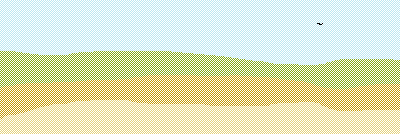Spadina Literary Review — edition 33 page 15
fiction

Falconry
by Habib Mohana
Thirty-year-old Jani was a brick maker at a kiln but every year in winter he would go falcon catching. One falcon could bring between one and two million rupees and Jani yearned to be rich. He needed a big amount of cash for his wedding.
This was his third season of falcon catching. He would get up when the muezzin called to Morning Prayer, then take only tea breakfast while his mother prepared a lunch for him which usually consisted of fried eggs and chapattis. He would hang an ancient telescope around his neck and sling a water canteen over his shoulder. He would strap a live young chicken to the handlebar of his rickety bicycle, and onto the rear carrier rack he would tie a white-eyed buzzard plus a wire cage known as a bal-chatri trap. Thus equipped, he straddled his bicycle and headed towards the hunting ground, a strip of stony plain five kilometers from the village, arriving just as the sun peeped up from the horizon.
He would park his bicycle in a straw hut and tie his lunch to a rafter. Then to the legs of the buzzard he fastened a feathered lure bristling with plastic snares, and he would toss the buzzard into the air. Its wings were hobbled with strings so it would come down to the ground after a hundred metres. The idea is that a falcon should see the hanging feathers and think the buzzard has a dead bird in its claws. Swooping to steal the dead bird, the falcon becomes caught in the snares sewn into the lure.
Jani would keep hurling the buzzard into the air until noon when he returned to the hut to eat lunch. Afterwards, another session of falcon catching would begin, this time using method number two, which entailed placing the chick in the bal-chatri trap. Its squawking would attract the falcon, which would swoop down and get caught in snares attached to the cage.
Those were the two methods to catch a falcon. But of course neither of them worked if no falcon showed up.
Towards sunset Jani would turn his steps back to the village.
One month into the falcon-catching season, and a hazy noon it was, an unusual bird appeared in the sky. Jani’s heart gave a thump of excitement. He lifted the telescope to his eyes and pointed it at the bird — it was a peregrine falcon. Jani hurled his buzzard into the air, but the falcon, displaying no interest, royally winged its way towards the hills and was swallowed by the haze. But after some time it returned, growing bigger with each wing beat. Jani’s eyes lit up with anticipation. Elegantly the falcon glided past the fluttering buzzard, then it circled and did a second glide-past, then it swooped. Falcon and buzzard wrestled in mid-air. Jani held his breath. He felt as if a stack of banknotes, a new mini truck, and a pretty bride were all dangling before him. The birds, interlocked, started spiraling down. They were a few metres from the ground when the falcon gained the upper hand. It soared off into the bluish dusty dome, majestically, with the buzzard wriggling in its claws. Jani dashed after them, as a marooned person pursues a vanishing rescue helicopter. The falcon grew smaller and smaller until it melted into the haze. Jani’s eyes were watering, partly from concentration and partly from disappointment. The October sky whirled in his eyes, he felt dizzy. He plonked down on the rubbly ground.
Next day Jani stumbled upon the bloody remains of his white-eyed buzzard among the rocks: a few splinters of bones, a scattering of feathers, a tangle of snares. He picked up the remnants and closed his hand over them. They smelt of the precious peregrine. They felt alive and warm to the touch. He felt as if he were holding the falcon itself.